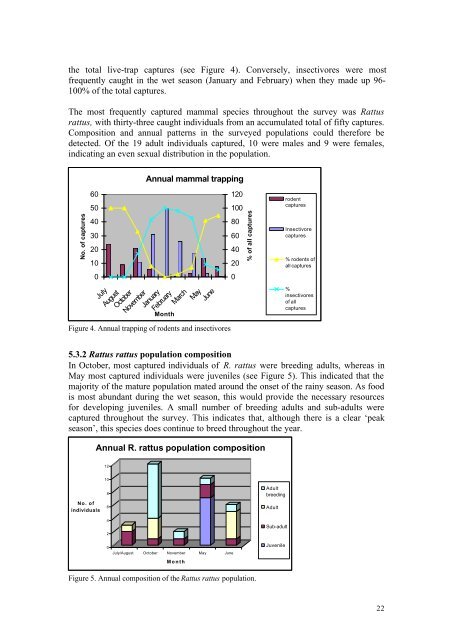The proposed Parc Regional de Belomotse - Frontier-publications ...
The proposed Parc Regional de Belomotse - Frontier-publications ...
The proposed Parc Regional de Belomotse - Frontier-publications ...
You also want an ePaper? Increase the reach of your titles
YUMPU automatically turns print PDFs into web optimized ePapers that Google loves.
the total live-trap captures (see Figure 4). Conversely, insectivores were most<br />
frequently caught in the wet season (January and February) when they ma<strong>de</strong> up 96-<br />
100% of the total captures.<br />
<strong>The</strong> most frequently captured mammal species throughout the survey was Rattus<br />
rattus, with thirty-three caught individuals from an accumulated total of fifty captures.<br />
Composition and annual patterns in the surveyed populations could therefore be<br />
<strong>de</strong>tected. Of the 19 adult individuals captured, 10 were males and 9 were females,<br />
indicating an even sexual distribution in the population.<br />
Annual mammal trapping<br />
No. of captures<br />
60<br />
50<br />
40<br />
30<br />
20<br />
10<br />
0<br />
July<br />
August<br />
October<br />
November<br />
January<br />
February<br />
Month<br />
March<br />
May<br />
June<br />
Figure 4. Annual trapping of ro<strong>de</strong>nts and insectivores<br />
120<br />
100<br />
80<br />
60<br />
40<br />
20<br />
0<br />
% of all captures<br />
ro<strong>de</strong>nt<br />
captures<br />
Insectivore<br />
captures<br />
% ro<strong>de</strong>nts of<br />
all captures<br />
%<br />
insectivores<br />
of all<br />
captures<br />
5.3.2 Rattus rattus population composition<br />
In October, most captured individuals of R. rattus were breeding adults, whereas in<br />
May most captured individuals were juveniles (see Figure 5). This indicated that the<br />
majority of the mature population mated around the onset of the rainy season. As food<br />
is most abundant during the wet season, this would provi<strong>de</strong> the necessary resources<br />
for <strong>de</strong>veloping juveniles. A small number of breeding adults and sub-adults were<br />
captured throughout the survey. This indicates that, although there is a clear ‘peak<br />
season’, this species does continue to breed throughout the year.<br />
Annual R. rattus population composition<br />
12<br />
10<br />
No. of<br />
individuals<br />
8<br />
6<br />
4<br />
2<br />
Adult<br />
breeding<br />
Adult<br />
Sub-adult<br />
0<br />
July/August October November May June<br />
Month<br />
Juvenile<br />
Figure 5. Annual composition of the Rattus rattus population.<br />
22
















